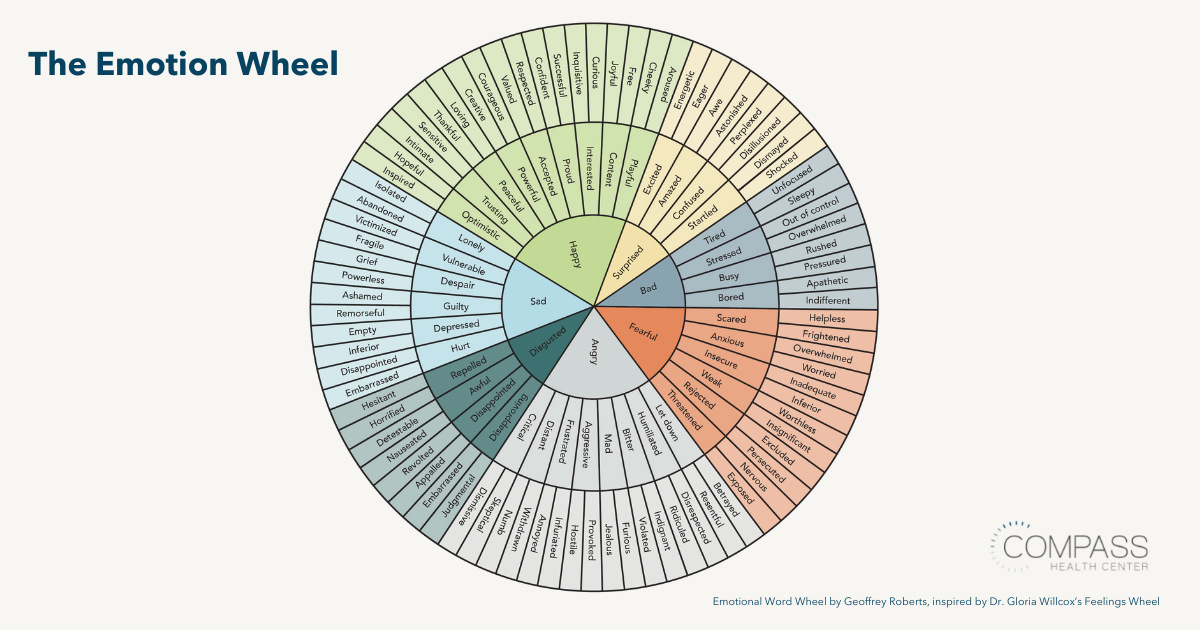As curious as it may sound, it can be hard at times to pinpoint exactly how we feel. Similarly, it can be a challenge to know when we should seek support and which type of support would be most appropriate and effective. When the emotions you’re experiencing are identifiable, choosing and practicing effective coping strategies or reaching out for treatment becomes more approachable. In this blog, Stephanie Clymer, LCSW, CADC, Primary Clinical Therapist at Compass Virtual, breaks down how to identify emotions to navigate your mental health and needs.
In most cases, we know what we are feeling in very broad terms. Sometimes, this may be enough, and we can take steps to change our mood or remind ourselves that feelings pass and then wait them out. However, digging a bit deeper to better understand how we are feeling and why in a more nuanced way is often helpful. Without doing so, the steps we take to try and help ourselves feel better may be ineffective or even counterproductive.
For example, I may understand that I feel upset. However, without knowing why or what “type” of upset, I cannot know whether a talk with a friend, a walk outside, a difficult conversation I’ve been avoiding, or some other strategy will lead me to feel better. Additionally, we may be unable to define how we feel or why. This is when outside tools and resources come in handy. Identifying how strongly or intensely we feel the emotions we are feeling and the degree to which they are impacting us at any given moment as well as over time is crucial to lasting and positive mental wellness.
If reflecting on your emotional state is overwhelming or challenging, the first step you can take is to ensure you’re feeling calm and thinking rationally. It is often impossible to think rationally if you are experiencing emotions to an extreme degree. If this is the case, try simple breathing exercises or mindfulness activities until you feel calmer. If you are relatively calm and still struggling to identify exactly how you feel, many resources are available. Talking through how you feel with a supportive person may be helpful. There are also visual and cognitive tools to help you identify, label, and understand your emotions, including the emotion wheel, the emotion iceberg, and the coping ladder.
The Emotion Wheel
There are many examples of emotion wheels or lists that can be found on the internet and elsewhere, like the one above. To use an emotion wheel, it is often easiest to start in the center, where the more general emotions are located. These emotions are more like categories than a description of our internal experiences.
Once you have identified the center emotion that is closest to how you are feeling, work your way outward through the more specific and nuanced emotions that are listed in that same-colored section to more closely pinpoint your emotional state and what may be underlying.
The emotion wheel is an incredibly helpful tool to better understand and process our emotions and communicate our internal experiences more clearly to others. When talking to a romantic partner, I could say that I am angry, and my partner may not respond in a way I find comforting because they do not clearly understand my distress. If I use the emotion wheel, I could instead identify that I am feeling jealous, frustrated, or resentful. Different needs cause these emotions, so a different response is required for each.
The Emotion Iceberg%20iceberg.png?width=1200&height=630&name=Three%20ways%20to%20Identify%20emotions%20(2)%20iceberg.png)
Let’s continue discussing the same emotions listed above when thinking of communicating with a partner: anger, jealousy, frustration, or resentment. Before a conversation, we can use the emotion iceberg to help us understand why we feel the way we do. This small change can greatly impact communication outcomes.
In the example above, anger is identified as the initial emotion. After utilizing the emotion wheel, let’s say that jealousy was the emotion that more accurately named the feeling. We can then create an emotion iceberg to further explore "jealousy” before sharing our thoughts with someone else so we better understand how we are feeling.
Think of an iceberg; what we see above the ocean's surface is often just the tip—they are much wider and extend much deeper underneath the water. The emotion iceberg can help us answer the “why” questions regarding our emotions. If we think of jealousy as the tip of our emotion iceberg, what is the reason for feeling jealousy at this moment? We all may list out different reasons. It could be past experiences of broken trust, personal insecurities, feelings of inadequacy, concerns surrounding importance, or many other factors. Once we understand the foundation of our iceberg, we can effectively share these thoughts with others so the whole iceberg is acknowledged rather than only the part above the water.
The Coping Laddercoping%20ladder.png?width=1200&height=630&name=Three%20ways%20to%20Identify%20emotions%20(4)coping%20ladder.png)
In addition to identifying how we are feeling, it is useful to identify the intensity of our emotions so that we can most effectively take action. After checking in with ourselves and possibly using an emotion wheel or other tool, the next question is: What level of distress am I currently experiencing? A mood rating scale and coping ladder can help us identify our next steps toward feeling better. There is a myriad of mood rating scales with different ranges and which use either end of the scale to identify positive/negative or level of intensity of emotion.
The graphic above is just one example, and you can choose or create one that works for you. Regardless of which scale you use, if you rate your level of intensity of emotion as being very high, your next step must be to bring that down (versus addressing/changing your actual emotion). This can be done by employing techniques related to the body, such as breathing exercises, shocking or soothing your senses, and progressive muscle relaxation. Once you have done this and brought down your mood rating, or if you identify from the get-go that the intensity of your emotion is on the lower end of your scale, you are likely in a rational state of mind and can employ more cognitive and complex skills and techniques to improve your emotional state. It is often helpful to break whichever scale you use or create into 3 zones:
Prevention Zone. Our prevention zone is a state of minimal mental health distress where we can think clearly and logically. This is a time when we can utilize cognitive coping skills.
Change Zone. Our change zone is a state of more intense feelings and internal distress; however, we can still think critically before acting. We can still use cognitive skills to express our emotions, and we can be mindful of needing to take breaks with a grounding or mindful activity if we feel like our mood rating continues to increase.
Crisis Zone. Our crisis sone is a state of dysregulation where we are unable to think critically or logically. Cognitive skills are not effective during this time because we are not feeling in control of our thoughts and emotions. It is helpful to use skills to help lower our mood rating during this time. Some examples of skills to use during these moments are labeling the items around you to give your mind a task, shocking your senses with a cold ice cube in your hands or a cold shower, eating something spicy to engage your taste buds, reaching out to a friend, or engaging in meditation. Once our mood rating enters the change zone, we can use cognitive coping skills.
Once you have created or found a mood rating scale that works for you, you can create a coping ladder by listing for each level/number the emotions you typically feel, thoughts you typically have, physical sensations you experience in your body, and behaviors in which you typically engage. To complete the ladder, add coping strategies, skills, and other resources and activities you can utilize at each stage to help bring your mood rating to a number or level that feels calmer and more manageable.
When to Speak to a Professional
Ongoing symptoms of anxiety and depression may make it more challenging to correctly identify our mood rating, our emotion on the emotion wheel, or explore the reasonings for our emotion using the emotion iceberg. If you attempt to use these techniques and the process feels clouded or overly challenging, reaching out to a professional for an assessment may be useful.
The therapist may ask how anxiety or depression impacts your communication, ability to go to school or work, complete assignments, do chores, or spend time with friends. A therapist might also ask you whether you’re experiencing physical symptoms such as headaches, nausea, and lack of sleep. They may want to know about the emotions you commonly experience as a part of your anxiety or depression that come up on your emotion wheel. For example, if you experience generalized anxiety, you might feel fear, panic, self-criticism, worry, rumination, and embarrassment. If you are experiencing depression, you may feel hopeless, inadequate, empty, incapable, and invaluable. In these situations, you may struggle to name other emotions as your thoughts continue to bring you back to these same emotions on the emotion wheel.
PHP/IOP: When Weekly Outpatient Therapy is Not Enough
Assessment for a more comprehensive, skills-based behavioral health program may be helpful if everyday life is challenging and you cannot keep up with areas of life such as hygiene, household tasks, work or school attendance, completion of assignments, and socialization. Compass Health Center’s Partial Hospitalization (PHP) and Intensive Outpatient (IOP) programs focus on learning evidence-based skills and techniques that help change current thought patterns so individuals can experience a broader range of emotional experiences.
Click here to learn more about Compass Health Center and whether a PHP or IOP program might be helpful for you or a loved one.





